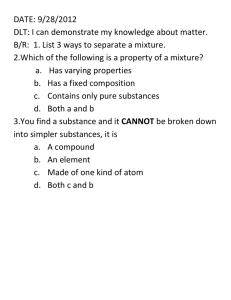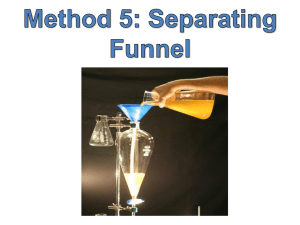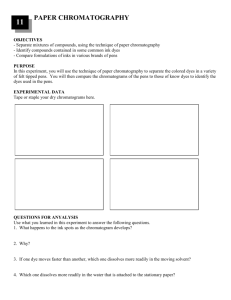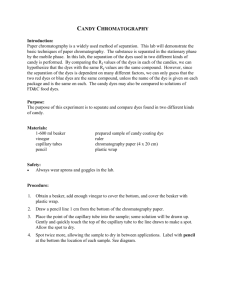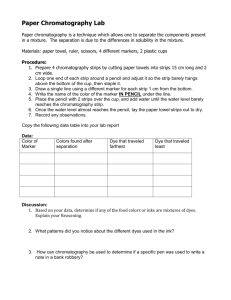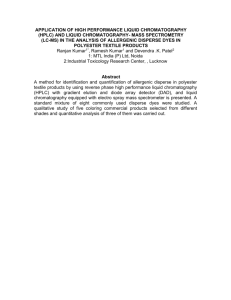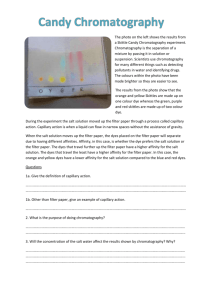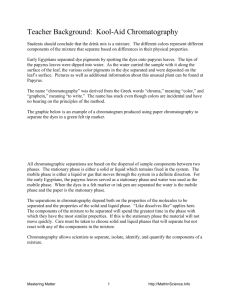Separation of pH Indicators Using
advertisement
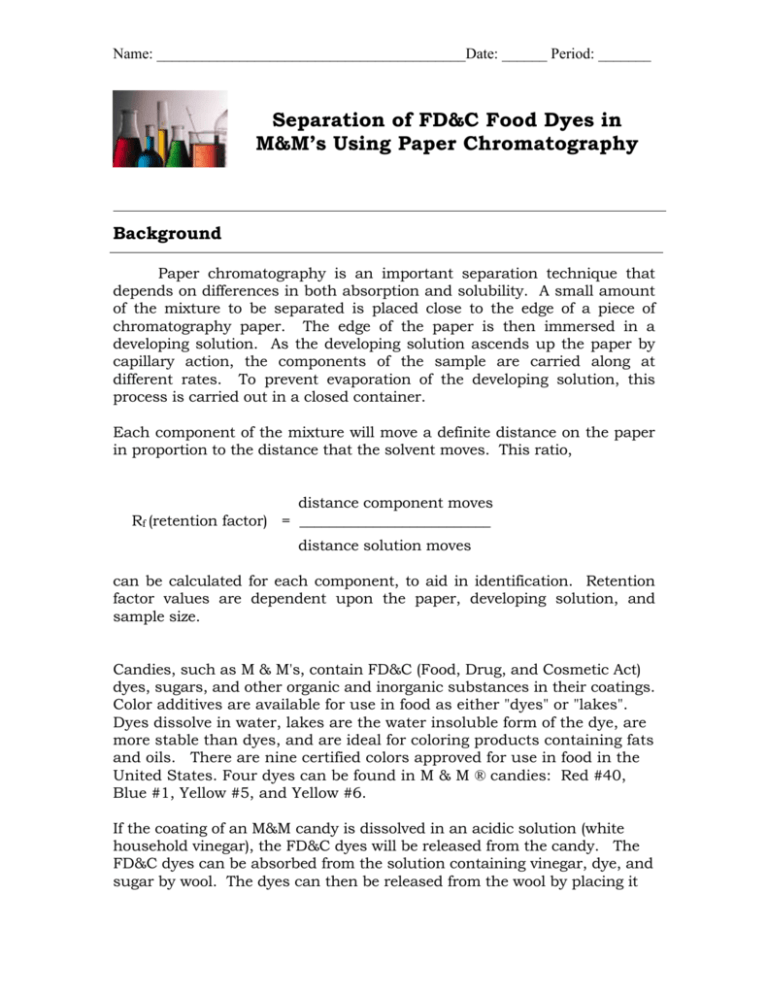
Name: _________________________________________Date: ______ Period: _______ Separation of FD&C Food Dyes in M&M’s Using Paper Chromatography Background Paper chromatography is an important separation technique that depends on differences in both absorption and solubility. A small amount of the mixture to be separated is placed close to the edge of a piece of chromatography paper. The edge of the paper is then immersed in a developing solution. As the developing solution ascends up the paper by capillary action, the components of the sample are carried along at different rates. To prevent evaporation of the developing solution, this process is carried out in a closed container. Each component of the mixture will move a definite distance on the paper in proportion to the distance that the solvent moves. This ratio, distance component moves Rf (retention factor) = __________________________ distance solution moves can be calculated for each component, to aid in identification. Retention factor values are dependent upon the paper, developing solution, and sample size. Candies, such as M & M's, contain FD&C (Food, Drug, and Cosmetic Act) dyes, sugars, and other organic and inorganic substances in their coatings. Color additives are available for use in food as either "dyes" or "lakes". Dyes dissolve in water, lakes are the water insoluble form of the dye, are more stable than dyes, and are ideal for coloring products containing fats and oils. There are nine certified colors approved for use in food in the United States. Four dyes can be found in M & M ® candies: Red #40, Blue #1, Yellow #5, and Yellow #6. If the coating of an M&M candy is dissolved in an acidic solution (white household vinegar), the FD&C dyes will be released from the candy. The FD&C dyes can be absorbed from the solution containing vinegar, dye, and sugar by wool. The dyes can then be released from the wool by placing it in an alkaline environment. This simplified equation represents the process involved: WOOL + DYE + H+ → DYED WOOL+ A solution of household ammonia can be used to supply sufficient OH─ to reduce the concentration of the H+ and cause the dye to be released from the wool. Purpose In this experiment, you will extract the dyes in candy coatings using wool and then separate the dyes using the technique of paper chromatography. If samples containing known FD&C dyes are run as standards, it is possible to identify the dyes used in the candy coatings. A sample containing a few micrograms of the dye is placed near one end of a strip of filter paper. That end of the paper is then immersed vertically in a solvent. As the solvent rises up the paper by capillary action it tends to carry the sample along with it, to a degree that depends on the solubility of the sample in the solvent and its tendency to adsorb on the paper. When the solvent has risen a distance of L centimeters, the solute, now spread into a somewhat diffuse zone or band, will have risen a smaller distance, say D centimeters. It is found that D/L is a constant independent of the relative amount of that substance or other substances present. D/L is called the Rf value for that substance under the experimental conditions. Rf = D = distance solute moves L distance solvent moves The Rf value is a characteristic of the substance in a given chromatography experiment, and it can be used to test for the presence of a particular substance in a mixture of substances with different Rf values. The first part of the experiment will involve the determination of the Rf values for five common acid-base indicators. These substances have colors that will allow you to establish the positions of their bands at the conclusion of the experiment. When you have found the Rf value for each substance by studying it by itself, you will use these Rf values to analyze an unknown mixture. Procedural Notes 1. Don't let the chromatography paper touch the sides of the beakers. 2. Handle chromatography paper carefully. Always handle the paper by the edges because their surfaces can easily be contaminated by your fingers. Materials Equipment: 2 pieces of chromatography paper (10 cm x 8 cm) 2 600 mL beakers 6 test tubes Test tube rack Glass stirring rod Forceps Beaker tongs 2 evaporating dishes 400 mL beaker Hot plate toothpicks 2 15 cm pieces of wool yarn 2 beral pipets Substances: 2 M&Ms of each of your assigned color of candy 1 set of standards FD&C dyes Vinegar Ammonia Pre-Lab Questions 1. What is the mobile phase in a paper chromatography investigation? 2. What is the stationary phase in a paper chromatography investigation? Number 1 Standard McCormick Red Food Coloring 2 Archer Farms Red Food Coloring McCormick Green Food Coloring McCormick Yellow Food Coloring Wilton Orange Food Coloring McCormick Blue Food Coloring 3 4 5 6 Components Red #40 Red #3 Red #40 Blue #1 Yellow #5 Blue #1 Yellow #5 Red #3 Yellow #6 Blue #1 Red #3 3. The table above lists the standards you will be given in this laboratory experiment. Which standard(s) would you need to use to determine the Rf values for the following FD&C food dyes? In some cases you might need to compare two standards to determine the Rf value for a specific dye. a) Red #40 b) Red #3 c) Yellow #5 d) Yellow #6 e) Blue #1 Procedure Part 1 – Extraction of Dye From M&M Candies 1. Place a 200 mL of water in a 400 mL beaker. Heat the water in the beaker until it is boiling. Turn off the hot plate once the water is boiling. 2. Add vinegar to the test tube containing M&Ms of your assigned color. You should add just enough vinegar to cover the candy in the test tube. 3. One at a time, hold a tube with a test tube holder and dip it into boiling water to heat the vinegar and dissolve the color coating, so that the candies turn white. The color comes off very fast, usually within a few seconds, so it is usually not necessary to keep it in there for longer than 10 seconds. Be careful to dissolve as little as possible of the white layer (sugar) under the colored layer and do not dissolve any of the chocolate. 4. Immediately pour the colored solution into a clean test tube, trying not to transfer any of the sediment. Repeat with the remaining test tube and M&M color. 5. Now you need to extract the dye from the solution onto the strips of yarn. To do this, place one piece of yarn into each test tube of colored solution and top off the level of vinegar so that there is at least 4mL (4cm). Heat the tubes in the boiling water bath for 5 minutes. You can remove the tubes from the water when the solution is milky-white and the yarn is the color of the dye, in other words, when all of the dye has been extracted from the solution. 6. Remove the dyed yarn from the solution and rinse it with distilled water. 7. Now it is necessary to extract the dye from the yarn and get it back into solution. Into 2 clean test tubes place a piece of yarn and 3mL of 1M ammonia. Make sure that the yarn is immersed and mix with a stirring rod, rinsing the stirring rod before placing it in each tube so as not to mix any of the colors. 8. Heat the tubes containing the yarn and ammonia in the water bath for 5 minutes or until the color of the yarn has faded. Remove the yarn. 9. You now may need to concentrate each color. Gently pour the ammonia solution into an evaporating dish. Take your evaporating dish to the fume hood and heat the dish on a hot plate until the solution is almost entirely evaporated. 10. Carefully remove the evaporating dish from the hot plate. You now have dye from M&Ms to separate using paper chromatography. Part 2 – Chromatography of Standards and Candy Dyes 1. Obtain chromatography paper and samples of each FD&C food dye from the front supply counter. 2. Place the chromatography paper on a clean dry sheet of paper. 3. Make a pencil mark about 2 cm from the end of the chromatography paper. Mark five equally spaced positions along the pencil line (the first and last positions should be at least 0.5 cm from the edge of the paper). 4. Use a toothpick to place a small spot (no larger than 5 mm in diameter) of each of the concentrated FD&C dyes on the marked positions. Allow the spots to dry completely. 5. Label the chromatography paper at the top (opposite of where you spotted the sample) so that you can identify which standard you applied. 7. Repeat steps 4 and 5 for the remaining standards and the concentrated M&M dyes, using a clean toothpick for each sample. 8. Cut the corners off the bottom of the paper (below the baseline). 9. Repeat steps 2-8 using the concentrated dye from the M&M samples. 10. Add 15 ml of vinegar to 2 different 600 ml beakers. 11. Carefully hand the piece of chromatography paper from a paper clip suspended over a glass stirring rod. 12. Place the paper in the beaker with the spots at the bottom of the cylinder. Be careful that the paper does not touch the sides of the beaker. Cover the beaker with plastic wrap and allow the chromatogram to develop until the developing solution is about 1 cm from the top of the paper. 13. Remove the paper from the beaker, open it out, and lay it on a piece of paper towel to dry. Mark the solvent line with a pencil, all the way across the paper. It is important you do this NOW. After the paper has dried, you won't be able to see the solvent line! 14. Let the strips air dry for completely. 15. Measure the distance from the center of the band to the point where the indicator was applied. Record this information in your data table. 16. For each sample (including the M&M dyes), also measure the distance from the solvent front to the point of application. 17. Clean and return all supplies to the front supply counter. 18. Wash your hands before leaving the lab today. Data Analysis and Conclusion 1. Which FD&C food color has the longest retention time? Which has the shortest? 2. Calculate the Rf (retention factor) ratios for each of the FD&C dyes used as standards. 3. Calculate the Rf ratio(s) per dye for the six M&M colors you tested. 4. Using the FD&C chromatogram and the calculated Rf values as standards, list the FD&C dyes used in your M&M experimental groups. 5. Some people are allergic to yellow #5 food dye. What colors of M&Ms should a person avoid if they are allergic to yellow #5? Example Data Table Table 1 – Paper Chromatography of FD&C Food Dyes Sample Distance solvent moved (cm) Distance sample moved (cm) Rf Color in NH3 vapor Color in HCl vapor
